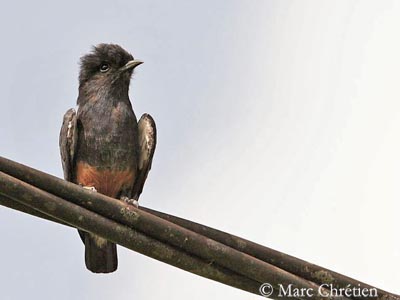
Swallow-Winged Puffbird or Swallow-wing
Chelidoptera tenebrosa
Piciforme Order – Bucconidae Family
BIOMETRICS:
Length : 14-15 cm
Weight : 31-40 g
DESCRIPTION:
Also called Swallow-winged Puffbird, the Swallow-wing is the only species of the genus Chelidoptera. It lives in South America.
PROTECTION / THREATS / STATUS:
Swallow-wing is usually locally common within its range, according to the availability of habitat.
This species is not threatened at this moment.
Fr: Barbacou à croupion blanc
All : Schwalbenfaulvogel
Esp : Buco Golondrina
Ital: Bucco alidirondine
Nd : Zwaluw-baardkoekoek
Port : Urubuzinho
Photographs by Patrick Ingremeau
TAMANDUA
Photograph by Marc Chrétien
His website :
MURINUS
Text by Nicole Bouglouan
Sources :
HANDBOOK OF THE BIRDS OF THE WORLD Vol. 7 by Josep del Hoyo-Andrew Elliott-Jordi Sargatal – Lynx Edicions – ISBN: 8487334377
A GUIDE TO THE BIRDS OF COLOMBIA by Steven L. Hilty and William L. Brown
Princeton University Press – ISBN 069108372X
L’ENCYCLOPEDIE MONDIALE DES OISEAUX - Dr Christopher M. Perrins - BORDAS - ISBN: 2040185607
Avibase (Lepage Denis)
Arthur Grosset's Birds (Arthur Grosset)
SORA Searchable Ornithological Research Archive (Blair O. Wolf)

Swallow-wing adult male is a plump bird. It has glossy blue-black plumage on the upperparts, including wings and tail. It has white rump.
Wings are broad. The short, square tail is black with very narrow whitish terminal band, visible in fresh plumage.
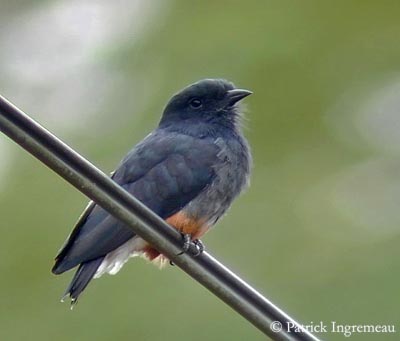
On the underparts, chin and throat are greyish with some fine longer feathers. The breast is blackish, turning grey on lower breast and upper belly. The lower belly is bright chestnut. The undertail coverts are white.
On the underwings, coverts and axillaries are white. The flight feathers are blackish, as the undertail feathers.
The head is entirely sooty-black. The strong bill is black and slightly down-curved. Eyes are dark brown. Legs and feet are blackish.
Both sexes are similar.
Immature resembles adults.
The Swallow-wing has three subspecies:
C.t. tenebrosa.
C.t. pallida is paler on the underparts, with white band between blackish breast and chestnut belly.
C.t. brasiliensis has paler ochraceous lower belly below a narrow white band which separates blackish breast from belly.
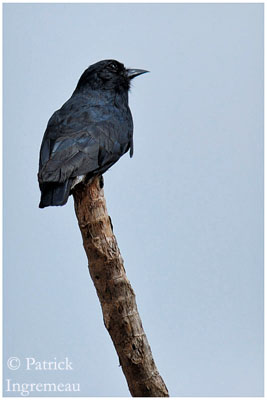
VOICE: wallow-wing is usually silent. Occasionally, it gives a weak piping “pi-pu” or “pit-wit-wit”. It utters twittering song in flight.
We can also hear a harsh, squeaky “tzeet” and a high, clear “di-didi di-didi…”
HABITAT:
Swallow-wing frequents varied types of habitats within its range. It is found in open savannahs with trees and shrubs, clearings, edges of different types of forests, scrub, along rivers and streams, gallery-forest, trees on the roadsides, up to 1000 metres of elevation, often lower. It needs sandy soils or earth banks for nesting.
RANGE:
Swallow-wing is found in northern South America, east of Andes, in the entire Amazon Basin, Brazil, Bolivia, Colombia, Ecuador, the Guianas, Peru and Venezuela.
BEHAVIOUR:
Swallow-wing feeds exclusively on insects. It catches them by rapid aerial sallies from a perch, as a flycatcher. When the prey is caught, it returns to the perch more slowly, performing undulations and circles before to back down to its perch.
It often swallows the prey in flight. This species is known to hunt for smaller insects than other puffbirds’ species.
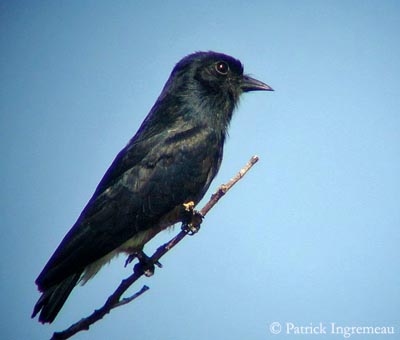
Swallow-wing may be seen solitary, in pairs or in small groups of 3 to 6 birds. It is resident in its range.
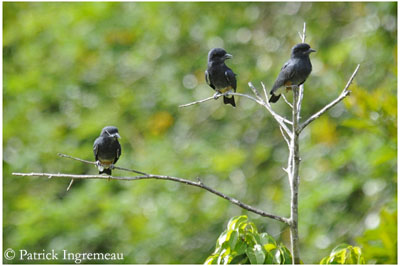
Swallow-wing, as other puffbirds, sometimes fluffs its plumage, in order to disguise it from predators.
The pair performs some displays in breeding season, singing in duet and male making short flights with spread wings before to return on the branch and sing again. This display may last several minutes.
FLIGHT:
Swallow-wing has fast and direct flight with rapid wing beats. It performs a graceful flight, shaping its wings for a rapid upwards attack and then, it circles slowly as a bird of prey, with elegant aerobatic movements. It is able to hover, or to swoop in slightly undulating flight to another place before to return to its perch.
REPRODUCTION:
Breeding season usually coincides with the start of the dry season, in order to reduce the risk of flooding in the burrow. The period varies according to the range.
The Swallow-wing nests in sandy soils where it is able to excavate the nesting burrow. It is often seen in sandy savannahs with some shrubs and trees, at the edges of the nearby forests.
This species is probably monogamous. The birds dig a burrow into the ground, of about one to two metres length. The entrance has a particular shape, often wider than high, about 6-7 cm height and 8-10 width. At the end of the burrow, there is the nesting chamber, lined with some bits of dry grass. The tunnel usually slopes downwards.
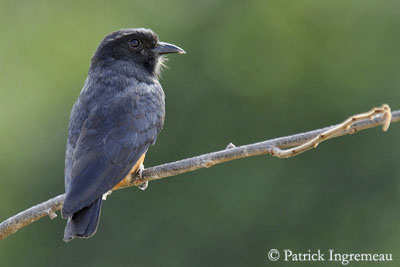
Female lays one or two white eggs. Incubation lasts about two weeks.
The chicks have black skin at hatching. They are able to move by crawling to the entrance of the tunnel, in order to be fed by both parents. They remain half-way into the tunnel for safe.
Female feeds the young during the first week after hatching, whereas the male feeds them in the burrow. But female still provides more food than male.
The fledging period is unknown.
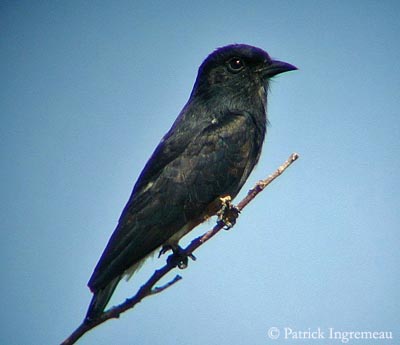
The major threat for this species is predation by snakes. However, the entrance of the burrow is concealed with leaves. Parents minimize the number of visits. The nestlings are silent and invisible, and any odour is perceivable. In addition, after the last feed of the day, the chicks retreat to the nest-chamber and make a mount of leaves that conceals them during the night.
DIET:
Swallow-wing feeds mainly on insects caught in flight by rapid aerial sallies from a perch. This species feeds on different preys such as bees, wasps, flying termites and flying ants. It usually swallows the preys in flight.
